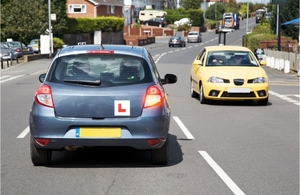Changes to the module 1 motorcycle test
The Driving Standards Agency (DSA) is making minor changes to the motorcycle module 1 test from 16 May 2011.

The government is working with the motorcycle industry to review the delivery and content of the motorcycle test. This working group includes DSA, Department for Transport, the motorcycle training industry and motorcycle user groups.
This work (along with DSA’s ongoing monitoring and review process of all tests) has identified a number of minor changes that can be quickly introduced before the main review is finished.
Change to the sequence of the manoeuvres
The slow speed elements will be carried out before the higher speed exercises. This will allow candidates to demonstrate the necessary competence in motorcycle control before moving onto the more demanding manoeuvres.
Controlled stop
This provides an opportunity for candidates to ride the circuit bend of the motorcycle manoeuvring area before coming to a controlled stop. There will not be a minimum speed requirement to this manoeuvre which will allow the candidates the opportunity to familiarise themselves with the layout before moving on to the emergency stop.
Emergency stop
This is to take place before the avoidance exercise. If candidates fail the emergency stop they will not be permitted to carry out the avoidance exercise. This is so that only sufficiently prepared candidates will undertake the avoidance exercise.
Choosing preferred riding line
Reposition cones on the exit of both left and right hand bends to allow the rider to choose their preferred riding line.
The slow ride
This will now be conducted whilst the candidate rides between the figure of eight and the U-turn manoeuvres. The examiner will observe rather than walk beside the candidate.
This will make for a smoother transition from one manoeuvre to another whilst compensating for the extra time required for the candidate to benefit from the additional ride around the circuit bend.
Altering requirements for the controlled stop following the avoidance exercise
The requirements for the controlled stop following the avoidance exercise will be altered.
The first pair of blue cones that currently form the stopping box will be removed for this exercise. The examiner will ask the candidate to stop between the remaining 2 blue cones. This will allow the candidate a greater length to stop in and also allows flexibility in where they stop.
Candidates will still be required to stop under control.
Flexibility of speed assessment
For the high speed manoeuvres, those candidates who reach 47 kilometres per hour (km/h) or less will be asked to repeat the exercise providing they haven’t committed a serious or dangerous fault and providing their riding doesn’t indicate it would be unsafe to continue.
A rider fault will be assessed as the candidate hasn’t achieved the minimum speed.
If the candidate fails to achieve the required minimum speed at the second attempt, a serious fault will be recorded.
Candidates who fail to reach the minimum speed requirement but who achieve 48 km/h or 49 km/h won’t be asked to repeat the exercise; a rider fault will be assessed in addition to any other control or observation faults. No more than one fault can be recorded for these exercises.
Candidates will still be required to stop under control.
(This section was updated on 13 June 2011)
Rider faults
The maximum number of rider faults a successful candidate is allowed will remain at 5; the number of attempts allowed for the higher speed exercises will also remain unchanged.
Summary
To summarise, these changes are designed to address those aspects the motorcycle industry felt needed to be changed.
The key message is that the exercises will remain the same; it is mainly the order in which they are delivered that will change. This will give candidates more time to settle down and familiarise themselves with the updated layout.
This will also give them the opportunity to build up their speed gradually, reducing the risk of candidates riding too fast.
Revised sequence of set exercises for module 1
The new sequence is:
- manual handling
- slow control steering - slalom and figure of 8
- slow ride - this will be observed as the candidate rides to the next exercise
- U-turn
- circuit bend and controlled stop carried out between 30 km/h and 50 km/h (about 20 miles per hour (mph) to 30 mph) followed by a controlled stop in the area marked by the 2 blue cones; speed not measured
- cornering and emergency stop; speed measured
- cornering, avoidance exercise and controlled stop; speed measured
For more information see the guide about the motorcycle practical test.